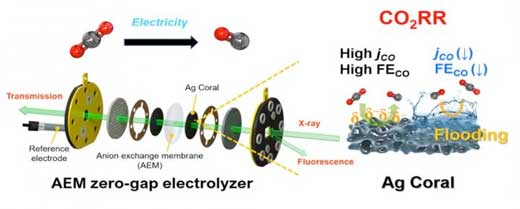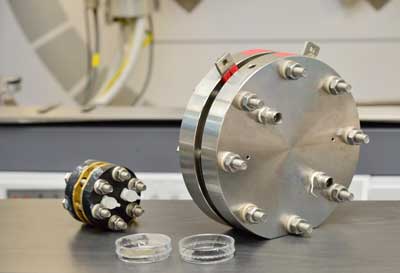| Jul 20, 2020 | |
High-performance large area electrode system developed for artificial photosynthesis(Nanowerk News) A research team, led by Dr. Hyung-Suk Oh and Dr. Woong Hee Lee of the Clean Energy Research Center of the Korea Institute of Science and Technology (KIST), working in cooperation with the Technische Universität Berlin (TUB), announced that they had developed a nano-sized, coral-shaped silver catalyst electrode and large-area, high-efficiency carbon dioxide conversion system, which can be used to obtain carbon monoxide (Nano Energy, "Highly selective and scalable CO2 to CO - Electrolysis using coral-nanostructured Ag catalysts in zero-gap configuration"). |
|
| In recent years, this type of electrochemical carbon dioxide conversion system has been a major area of research in the field of artificial photosynthesis. | |
 |
|
| Coral-shaped schematic diagram of carbon dioxide conversion systems using electrodes. (Image: Korea Institue of Science and Technology) (click on image to enlarge) | |
| Artificial photosynthesis is a technology that converts carbon dioxide, a cause of global warming, into usable chemical substances with high values. In order words, this type of technology removes carbon dioxide from the environment, decreasing pollution, and converts it to obtain useful chemical substances. The electrochemical carbon dioxide conversion field, in particular, has recently been receiving much interest from the scientific community. | |
| In the past, carbon dioxide conversion research was mainly conducted on the compound in its liquid state. When using liquid, however, the performances of different conversion systems have to be measured by immersing electrodes in water. Since carbon dioxide does not dissolve well in water, it is difficult to obtain sufficient efficiency using this process, compared to the amount of energy used. | |
| Recently, a system was developed that could convert carbon dioxide using the compound in its gaseous state. This raised the expectation that a high-efficiency conversion system would soon be achieved; however, this proved difficult due to a lack of catalysts and electrodes that could be applied to the new system. | |
| To solve this problem, the joint KIST-TUB research team developed coral-shaped, nano-sized silver catalyst electrodes that could be applied to high-efficiency carbon dioxide conversion systems utilizing carbon dioxide in its gaseous state. | |
| Compared to other silver catalysts, the newly developed catalyst requires a low amount of energy to achieve a reaction and can produce over 100 times more carbon monoxide than liquid-based systems. The electrodes of the carbon dioxide reducing system were also successfully applied to large areas (50 cm2), showing great promise for commercialization. | |
 |
|
| (Right) Coral shape silver nano-catalyst electrode with high-performance, large-area developed by KIST researchers (electrode size 50 cm) (Left) Catalyst electrode for synthetic photosynthesis in existing gas state (electrode size 2cm). (Image: Korea Institue of Science and Technology) | |
| The KIST-TUB researchers were also able to develop a catalyst through various operando analysis. The team confirmed that the coral-shaped, silver nano electrode catalyst, produced using chlorine ions through a real-time, x-ray absorption analysis method, has high substance delivery capacities, thanks to its large surface area and porous structure. This means that the catalysts demonstrates high efficiency in the carbon dioxide conversion process. | |
| They further found that the carbon dioxide conversion process was less efficient when there was no hydrophobicity during the reaction; this means that a certain level of hydrophobicity must be maintained when developing carbon dioxide conversion electrodes in the future. | |
| Dr. Hyung-Suk Oh of the KIST, who jointly led the research, said, "By developing nanometer-sized, coral-shaped silver catalyst electrodes, we were able to greatly improve current density and the performance of the electrochemical carbon dioxide conversion system, thereby suggesting directions for future research." He added, "It is expected that this study will greatly contribute to the R&D of electrochemical carbon dioxide conversion systems." |
| Source: Korea Institute of Science and Technology (KIST) | |
|
Subscribe to a free copy of one of our daily Nanowerk Newsletter Email Digests with a compilation of all of the day's news. |
